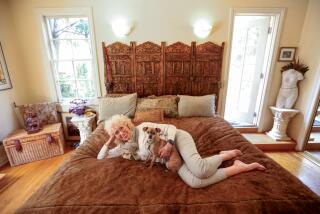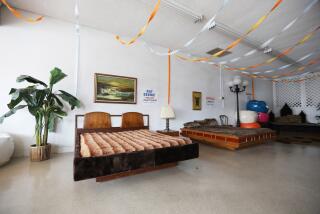Notes on Armoires, Victorian Baths and English Muffins : Treasure Hunting : Victorian Bathroom Fixtures
- Share via
UNTIL THE 1870s,the bathtub was a portable tin basin. For the wealthy, it might have been gilded and fancifully wrought in the shape of a fish, swan or seashell. Servants placed it before a boudoir fireplace, then filled it from buckets of hot water carried upstairs. Less affluent Americans, meanwhile, bathed in a kitchen washtub.
By the 1880s, mass production put complete bathrooms into most American homes. Sinks and tubs were marble or metal, their pipes hidden by skirts or marble-topped chests. Decor was fancy: Persian throw rugs, wainscoted walls, windows of stained glass.
When germs were first identified during the Gay ‘90s, bathrooms acquired a more clinical look. Walls were white enamel, floors were covered with scrubbable, white hexagonal tiles. Tubs were raised on claw feet, and sinks were perched on easily cleaned pedestals. Polished brass faucets and pipes were often left exposed.
Fixtures from the Victorian Era are extremely popular these days. Perhaps the largest selection of antique claw-foot tubs in town can be found at Big Ten Building Materials in Altadena, which also stocks new and used pedestal sinks. L.A. Wrecking Yard and Frank Daniels Central Wrecking Yard, both in Los Angeles, carry Victorian-style white porcelain faucets, knobs, flushers, pull chains and footed gas radiators. Authentic fixtures can be both purchased and restored at Vintage Plumbing Specialties in Northridge. And for reproductions, Snyder-Diamond Plumbing (various locations in the L.A. area) stocks a particularly handsome pull-chain toilet with brass pipes and an oak overhead tank--no refurbishing or refinishing needed.
DR


